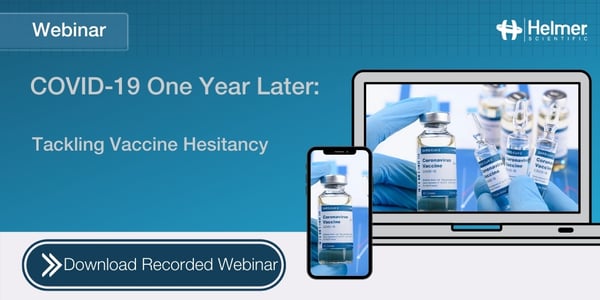
Just last week, the FDA authorized the Pfizer vaccine for use in children between the ages of 12 and 15. Additional clinical trials are underway, and it is expected that Moderna will soon be available to this age group, and both vaccines will become available to younger children later this year. With over 50% of U.S. adults receiving at least 1 dose of the COVID-19 vaccine and adolescent vaccination kicks off, the U.S. is moving into a new phase of vaccine rollout. This new phase will look to tackle vaccine hesitancy and increase confidence in the COVID-19 vaccines, with the help of healthcare and primary care providers.
In December of 2020, 39% of polled Americans classified themselves as “wait and see” in determining percentage of American public who would or would not get the vaccines. A few months into the vaccine rollout, 66% of this “wait and see” group say they are more likely to get the COVID-19 vaccine if they heard that vaccines are nearly 100% effective at preventing hospitalization and death from COVID-19. In last month’s webinar, Dr. L.J. Tan, MS, PhD, Chief Strategy Officer at the Immunization Action Coalition (IAC), called this group the “movable middle.” Meaning, this group is on the fence and the opportunity is there for healthcare providers to help drive vaccine confidence.
Trust in the safety and efficacy of the vaccine continues to be an important deciding factor. There is also a perceived higher risk in getting vaccinated vs. contracting COVID-19. Dr. Tan outlined several strategies for building confidence in the vaccine and overcoming vaccine hesitancy. These models include the Canadian ASK Approach for Effective Immunization Communication, the CASE Model for Conversations About Vaccines, and the Principles of Motivational Interviewing.
The Canadian ASK Approach outlines three steps required for effective communication about vaccines.
Acknowledge the patient’s concerns. Ask for clarification to understand those concerns. Sometimes a simple fact is all that’s needed to dispel a myth or misunderstanding.
Steer the conversation. Refute the myth or misunderstanding with facts.
Know your facts; be confident and prepared. Recommend or provide reading material, refer the patient to reliable source and make your professional recommendation crystal clear.
The CASE Model takes a similar approach, but on a more personal level by including provider experience with the vaccine into the conversation.
Corroborate. Acknowledge the patient’s concern, find a point of agreement, and set the tone for a respectful conversation.
About Me. Talk about your own personal experience getting the vaccine, and what you have done to enhance your knowledge and expertise of the vaccine.
Science. Describe what science has to say about the topic in question.
Explain and advise. Offer your recommendation, based on the science.
Lastly, The Principles of Motivational Interviewing can help in changing the patient’s behavior. Remembering the acronym RULE, can help.
Resist the righting reflex
Understand the motivations
Listen
Empower
The above methods may seem intuitive to most health care providers, but they are important tactics to familiarize yourself with as we move into this next phase of COVID-19 vaccine rollout.
OTHER BLOGS YOU MIGHT BE INTERESTED IN...
- Webinar Recap | COVID-19 One Year Later: Vaccine Progress and New Standards for Vaccine Storage
- Rising to the challenge to support COVID-19 vaccine cold storage
- Resources for Maintaining Immunization and COVID-19 Vaccine Development Update
- The Critical Importance of Improving Immunization Rates During COVID-19
For more information on the COVID-19 vaccine rollout and methods for tackling vaccine hesitancy, watch the webinar recording from our latest webinar, COVID-19 One Year Later: Vaccine Progress and New Standards for Vaccine Storage.




